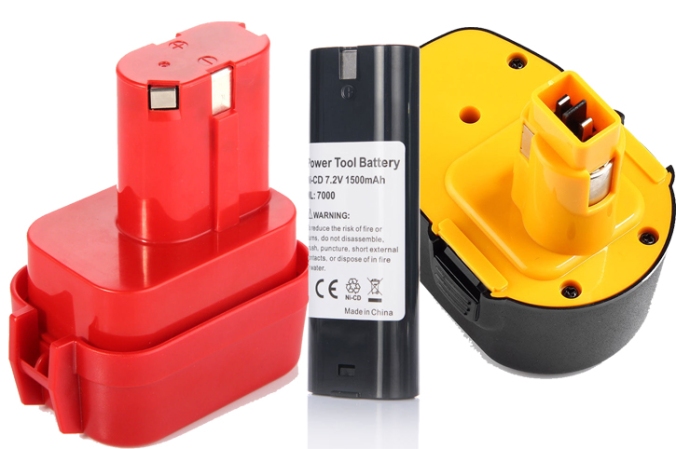There’s a GREAT article here. Here’s a brief excerpt (ALL CREDIT GOES TO THE ORIGINAL AUTHOR!)
There are three major rechargeable battery technologies in use today for cordless power tools: nickle cadmium (NiCd), nickle metal hydride (NiMH), and lithium ion (Li-Ion).
We describe these battery types below, list pros and cons, and offer an overview of characteristics and specifications for each.
Nickle Cadmium (NiCd)
The oldest design of the three, NiCd batteries are still in use today because they are tough, inexpensive, and have a long cycle life. Although they are still great for some jobs, NiMH and Li-Ion outperform NiCd batteries overall.

Pros:
NiCd batteries are more difficult to damage from heat and impact.
NiCd batteries have a longer cycle life of about 1,000 charges.
They put out strong current flow.
They are less easily damaged by being stored in deep discharge, although it is still not recommended.
They are less expensive than other rechargeable batteries.
Cons:
Nickel Cadmium batteries are the heaviest of the three types.
Lower capacity than other batteries.
NiCds shouldn’t be allowed to drop below about 70% charge between charges, or the battery lifetime can be shortened.
Most NiCd batteries must be allowed to cool before being recharged.
Must be allowed to deep discharge about once a month or they will suffer severely from memory effect.
The cadmium in NiCd batteries is very damaging to the environment and must be disposed of correctly.
NiCd Battery Overview:
cycle life: long; 1000+ charge cycles
self-discharge: moderate, 15%-20%
capacity: low; 1.2 Ah – 2.2 Ah
optimal charge time: fast
maintenance: high; deep discharge once/month
memory effect: high if not maintained properly
sensitivity: very tough
Nickle Metal Hydride (NiMH)
A newer technology, NiMH batteries improve upon NiCd in several ways, including less toxicity to the environment.
The biggest improvement with NiMH is their increased capacity, which can be two to three times longer than NiCd batteries. However, NiMH are also very sensitive to storing and charging conditions.

Pros:
NiMH batteries are a little lighter than NiCd batteries.
They have a higher energy density, meaning that their capacity is greater than NiCd batteries, running 2 to 3 times longer in a single charge.
They are less expensive than Li-Ion batteries.
Capacity loss can be reduced drastically if charged and stored properly, making it possible to greatly increase their cycle life.
They are not destructive to the environment.
Cons:
NiMH batteries are more sensitive to temperature, especially cold temperatures, and should only be stored or operated between about 33°F – 103°F.
Deep discharge and lack of use will damage NiMH batteries, shortening their lifespan and limiting their storage capacity.
Should usually be charged after reaching 70% capacity, but should also be allowed to deep discharge every three months to avoid memory effect.
They are more expensive than NiCD batteries.
NiMH Battery Overview:
cycle life: varies; can be as long as NiCd if stored and charged correctly.
self-discharge: fast; 20%-30%
capacity: moderate; 2.2 Ah – 3.0 Ah
optimal charge time: fast
maintenance: moderate; deep discharge once/three moths
memory effect: moderate; can be avoided with proper charging
sensitivity: very sensitive to temperature
Lithium Ion (Li-Ion)
Lithium ion batteries (Li-Ion) are the newest technology in rechargeable batteries to be introduced to cordless power tools. They are definitely the best choice of the three types of batteries, outperforming in all areas, but they are also expensive.
Heat is the biggest risk to Li-Ion batteries. Because they do not suffer from memory effect, Li-Ion batteries do not wear out over time because of charging issues. Instead, Li-Ion batteries wear out because of age and use.
Regular age and use wear down the internal components of Li-Ion batteries and reverse their electro-chemical processes. Heat, at any time during use or charging, is the major cause of accelerated deterioration in Li-Ion batteries.

Even with their relatively short life cycles, Li-Ion remain a better choice because of they charge fast and have a high capacity. Also, because the technology is still pretty new, Li-Ion batteries are still seeing many improvements that overcome their minor disadvantages.
Pros:
Li-Ion batteries are the most light-weight of the three kinds of rechargeable batteries.
Li-Ion batteries benefit from high energy density like NiMH batteries do.
They are much less sensitive to damage from temperature changes than NiMH batteries.
Li-Ions are not restricted in the shape of their design like NiCd and NiMH batteries are, and can be designed in almost any shape for better tool balance.
They do not suffer from self-discharge and memory effect like NiCd and NiMH batteries, meaning that they’re much less sensitive to recharging and storage methods.
They have the longest charge/recharge life cycle of all three types of batteries.
Li-Ion batteries are not destructive to the environment.
Cons:
Excessive overheating of Li-Ion batteries can damage or destroy them, which can occasionally happen during recharge. However, most rechargers and Li-Ion batteries are designed with safety features to prevent overheating.
They have the shortest overall life cycle of about 300-500 charges.
Li-Ion batteries are the most expensive batteries of these three types.
Li-Ion Battery Overview:
cycle life: short; 300-500 cycles, or about 2-3 years.
self-discharge: very slow or not at all.
capacity: high; 3.0 Ah+
optimal charge time: moderate
maintenance: none
memory effect: none
sensitivity: sensitive to heat and impact











